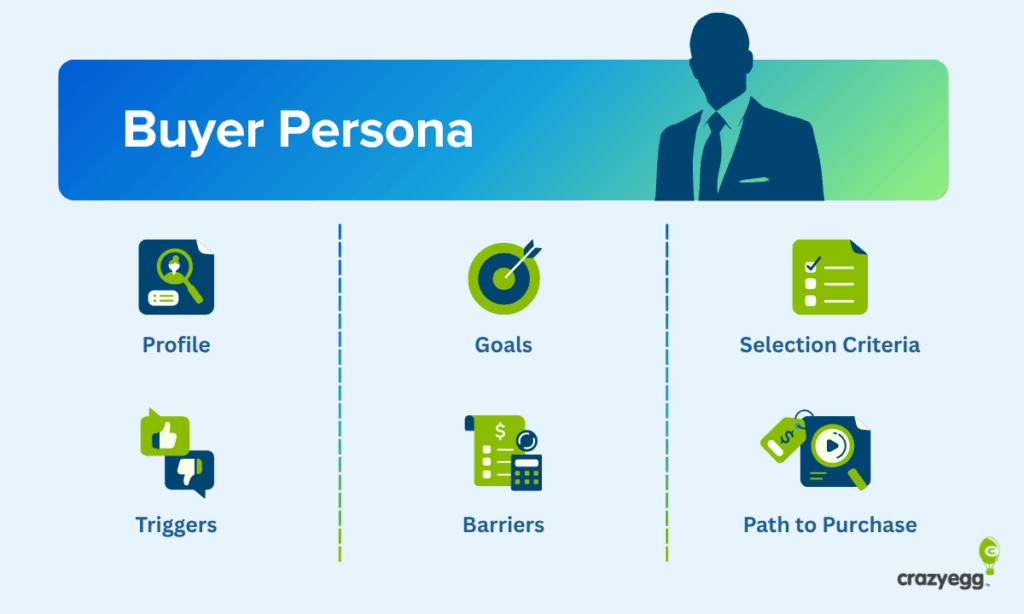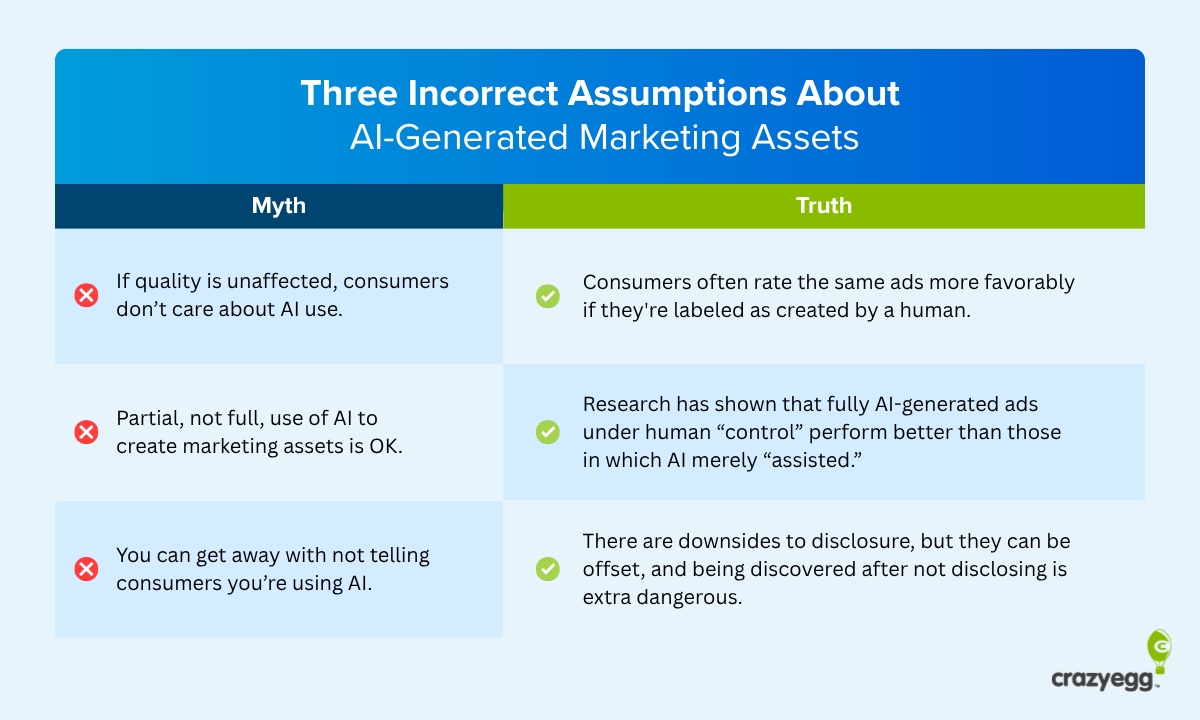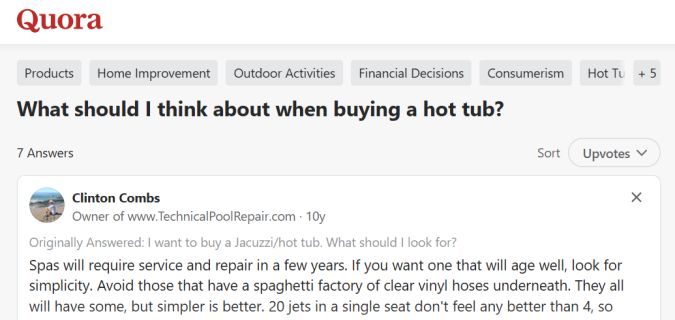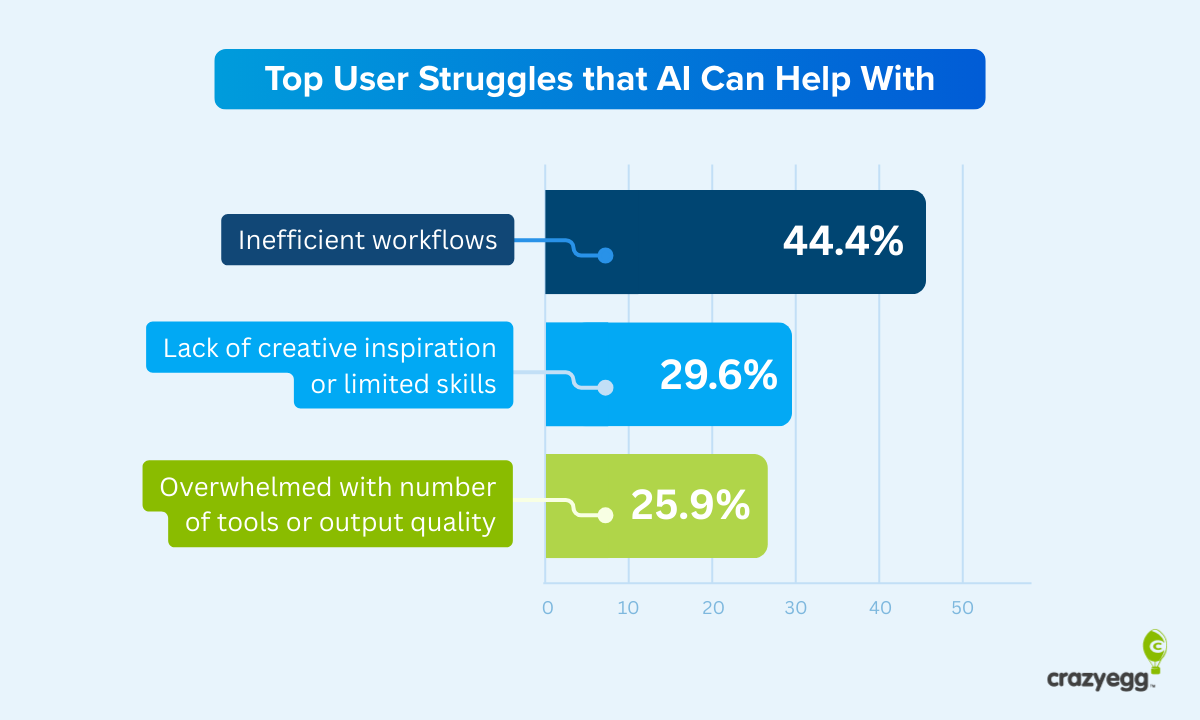Most buyer personas have as much depth as a middle-school book report: fictional profiles with stock photos, generic hobbies, and surface-level traits.
Then there are personas built from interviews with real buyers. They capture the specific concerns that almost derailed the deal, the questions that came up repeatedly, and the moment the buyer finally felt ready to commit.
This kind of buyer persona becomes a helpful reference point. Marketers know which messages will resonate. Sales reps know where prospects get stuck, and how to help them move forward.
What is a Buyer Persona?
A buyer persona describes how real customers in your target market make purchase decisions. You build it from a mix of customer interviews and market research, using data and quotes from actual buyers to contextualize their choices.
The point of a buyer persona is to understand what’s on a potential customer’s mind as they debate whether or not to make a purchase. What problems are urgent? What outcomes are they looking for? What drove them to consider buying something new?
In other words, a good buyer persona makes the hidden decision drivers visible so that your team can go out and win more business.
It allows you to connect what real buyers want with what your brand does best. That alignment drives effective decision-making across teams:
- Content development: Write copy speaks directly to real-world goals and barriers.
- Brand positioning: Clarify how your solution compares to competitors through the lens buyers actually use.
- Campaign Targeting: Target triggers and goals with the right channel, timing, and creative.
- Thought leadership: Publish content related to buyers’ challenges and selection criteria.
- Sales enablement: Arm reps with language that echoes how customers describe their problems and insight into what triggers urgency.
- Product development: Prioritize features based on the outcomes that matter most to buyers.
Why buyer personas come from conversations, not guess work
You will see a lot of people say that “buyer personas are useless,” and it’s usually because they interacted with one that was done poorly.
It takes about 10 seconds to fill in a buyer persona template (there are tons of them) with the market research data you already have. But it will be useless.
You have to talk to customers in order to find out what’s on their mind.
Nothing matches hearing a prospective buyer explain why they moved forward, or why they didn’t. You get all sorts of insights about your brand, your competitors, and how your buyers frame their needs.
When interviews aren’t possible, you can pull insights from surveys, sales calls, or support tickets. Those sources add context, but can’t fully replace direct conversations with prospective buyers.
For example, a person might say that they switched to another provider due to cost. But when prompted to say more, they share that the price recently jumped due to a licensing change, or that they expected a better ROI, or that the tool doesn’t do what was promised and so they have had to keep tools they were trying to migrate away from.
So yes, cost is a factor for switching that you could pick up with a survey, but you wouldn’t get the second-level data.
In fact, the survey-level data would probably be misleading in this example because you might come away thinking that customers are price-sensitive (e.g. 45% customers cited “cost” as the most important factor in switching). Yet, the deeper reasons in those examples (like low ROI) indicate that it’s a cost/capabilities mismatch, not price-sensitivity. These interviewees aren’t seeing the value they expected for the price.
There is no shortcut that will get you this type of information. It’s not in blogs, product reviews, or social media. It’s entirely in the head of customers who, 99% of the time, have never thought about the questions you want them to answer.
“No one has ever asked me that before,” is a statement you will hear a lot once you start interviewing buyers.
The difference between a buyer persona and an ICP
A lot of confusion comes from treating buyer personas and ICPs as interchangeable. They’re not, and you need both.
An ideal customer profile (ICP) is a short description of the type of customer most likely to need and benefit from your product. It usually includes demographic and firmographic details such as company size, industry, role, revenue band, and sometimes psychographic attributes like “innovation-minded” or “cost-sensitive.”
A buyer persona explains how someone inside that ICP thinks, chooses, and acts. It’s the factors that held weight in their mind as they moved from need, through hesitation, and ultimately to purchase.
These are complementary tools that serve distinct purposes:
- The ICP tells you who is worth targeting.
- The buyer persona gives you insight into how to engage and convert them.
A buyer persona is not an ICP with a fake headshot.
That’s the mistake people make when they use buyer persona templates and just plug in the information they already have from their ICP.
I recommend using both. In practice, it makes sense to lock down your ICP before developing buyer personas. Otherwise, you risk doing deep research on the wrong people.
What Should Be In a Buyer Persona?

You have complete freedom to structure a buyer persona any way you want. There are many different templates and frameworks out there.
I’ve outlined six core components:
- Profile
- Triggers
- Goals
- Barriers
- Selection criteria
- Path to purchase
The following sections define each component and explain why it is important. I’ve also included examples of customer quotes that might be surfaced during interviews and used as supporting evidence in each section.
1. Profile
The profile captures basic context: role, company size, industry, and a few key demographics. On its own, it doesn’t explain behavior, but paired with the other components, it helps you show whose story you’re telling.
- “We’re in a legacy industry that resists change.”
- “I’m mid-career, so I’m careful about making risky calls.”
- “I manage operations at a 200-person SaaS company.”
2. Triggers
Triggers explain what sets a buyer in motion. They’re the events or pressures that make someone start looking for a solution now instead of later. Seeing the trigger helps you understand urgency and timing.
- “Our old vendor raised prices and it forced us to look around.”
- “I got promoted and suddenly had to report on metrics I’d never tracked before.”
- “We saw a competitor’s press release and realized we were falling behind.”
3. Goals
Goals express the real-world outcomes that buyers want to achieve. These could be concrete and practical, like saving time or money, but they are often emotional, like looking smart in front of leadership.
- “If I can get five hours back each week, that’s a win.”
- “I need to show the board cleaner reports, fast.”
- “Honestly, I just want to stop worrying about this every day.”
4. Barriers
Barriers are the fears and hesitations that get in the way of a purchase. They can be well-founded or based on misconceptions. Knowing barriers makes it clear why a buyer might stall or walk away.
- “We tried a tool like this before, but no one ended up using it.”
- “Switching feels like it would take months we don’t have.”
- “It sounds good, but it’s not clear if it’s worth the cost.”
5. Selection criteria
Selection criteria reveal how buyers judge their options. These are the factors that are top of mind for buyers as they weigh risks and opportunities on their way to a final decision.
- “If it doesn’t integrate with Slack, it’s a nonstarter.”
- “We’ll pay more if the support is better than what we have now.”
- “I need to know if other companies our size are using it successfully.”
6. Path to purchase
The path to purchase shows the steps buyers typically take on their way to a decision. Where do they discover the brand? Who do they talk to? Where do they go to learn more? Mapping the customer journey helps you understand a buyer’s headspace at each step.
- “I always check G2 before I talk to a salesperson.”
- “Once IT is involved, things slow down for weeks.”
- “I usually want to try it myself before I pitch it to my boss.”
Should I include a name and image of my buyer persona?
That’s up to you. Personally, I think a name is very valuable, and an image is worthless at best.
Naming your buyer persona is a great way to give the basic gist to people. For example, a company that sells pizza ovens might have discrete buyer personas for the Backyard Chef and Pizza Chain Manager.
I do not recommend giving a real name, like Backyard Chef Brian. What does that add? I get that the idea of personas is to humanize buyers, but in practice these names don’t really add any value and they tend to be distracting.
I also do not recommend including an image of the buyer persona. This is always arbitrary. There’s no image of a fake person that’s going to provide guidance to a sales rep in conversation.
If you absolutely must have an image in your buyer persona to check the box, I recommend using an illustration. They are easy enough to whip up with AI and they avoid a lot of the stereotypes tied to stock photos.
The rest of the information in the buyer persona comes from conversations with real customers. It’s much more important, and that is where your focus should be.
Example Buyer Persona
Let’s take a quick look at this mock buyer persona I created for a company that is trying to sell high-end pizza ovens.
They have a few different customer types, both business and consumer, and there is a particular residential buyer persona they have identified as: The Backyard Chef
Here is a complete buyer persona with an example customer quote in each section.
Profile
- Age 35–50, suburban homeowner with backyard
- Cooking/hosting hobbyist with disposable income
- Enjoys entertaining and showing off cooking skills
“Cooking is my hobby, but it’s also how I bring people together.”
Triggers
- Wants to level up from grill/smoker
- Frustrated with conventional oven results
- Saw friends/influencers cooking perfect pies
“I’m tired of doing 450 °F in my regular oven and just crossing my fingers.”
Goals
- Consistent, restaurant-quality pizza
- Cooking without hassle or guesswork
- Expanding outdoor cooking repertoire
“We host friends twice a month. I want the food to be a highlight”
Barriers
- High upfront cost
- Fear of complexity/steep learning curve
- Concerns about maintenance or fuel
“$1,200 is a lot. What if I only use it a few times a year?”
Selection Criteria
- Fuel flexibility (wood, gas, charcoal)
- Temperature range + stability
- Warranty, build quality, and reviews
“I want to see pizzas real people made, not just staged marketing shots.”
Path to Purchase
- Browses reviews, forums, and videos
- Looks for real-user photos/videos
- Waits for discounts
“I went down a rabbit hole on YouTube before pulling the trigger.”
5 Steps To Create a Buyer Persona
1. Set up interviews with prospective customers
Conducting in-depth, one-on-one interviews is ideal. You can get to the deeper, often emotional reasoning that factored into their decision.
The best interviews will be with prospective customers. Consider reaching out to people that are in your website funnel that have yet to buy. Email subscribers are an obvious place to look.
Another good source of interviews are customers who went through your sales process but did not ultimately buy. I wouldn’t only look at people from this group, but I would try to interview at least a few. Former prospects and lost deals can be very insightful.
Existing customers can be helpful to interview, but I would try to talk with prospects. Your existing customers aren’t on the market right now, and might not have been for some time. Their insight into today’s buying process may not yield as vital information.
If you conduct 10-20 interviews, you will start to pick up on trends and commonalities that can help you hone in on the real triggers that push people into the market, the outcomes they want, the barriers in the way, and the key moments in their journey to purchasing or walking away.
Some tips for setting up meaningful interviews
- Plan to conduct at least 10 interviews. More is better.
- Only interview people directly involved with recent sales.
- Don’t interview any leads currently associated with a sale.
2. Round out your research
Interviews are the core of a strong buyer persona, but if that’s all you rely on, you’ll miss the bigger picture. You need more inputs to make sure the persona reflects what’s actually happening in your market.
Start with your competitors. Look closely at how they position themselves, which keywords they are targeting, and who their campaigns seem built for. That tells you both what buyers are hearing elsewhere and how you can differentiate your brand.
Then see what you can find out from the chatter in your niche. Industry sites, forums, communities, and social media are a great place to mine. Social listening tools can be helpful for identifying the words people use when they talk about their problems, their wish list, or their frustrations.
Your own customer data is another key source. Support tickets, reviews, and feedback forms are full of clues about what people value and where they struggle.
The goal in this section is to get enough data on your customers to start filling in the buyer persona. You’ll have high-confidence in some of your data, less in others parts. This knowledge will help you orient interviews with customers to get at the parts of the buyer persona where you have the least clarity.
3. Conduct customer interviews
Once you’ve done your background research, it’s time to talk to real customers. The goal is to uncover how people think, what drives their decisions, and what stops them from moving forward.
The best way to do this is maximize your listening time. Keep them talking. Ask open-ended questions, dig deeper with follow-ups, and always push for that next layer of detail.
- Book interviews for 1 hour, but aim to end 15-20 minutes early.
- Always get permission to record interviews.
- Give interviewees time to answer.
- Start with broad questions and then get into the weeds.
4. Pull insights from your research
At this point, you have up-to-date market research and at least 8-10 hours of interviews with potential customers. The next step is turning that raw input into insights you can share in a sentence.
Start by organizing everything. Transcripts, notes, reviews, and feedback all need to be in one place. It can be a doc, spreadsheet, Notion, Coda, whatever you are comfortable with.
From there, the job is to pull out recurring themes. You can hand-code for insights if you prefer, but this is one area where AI tools are undeniably useful. It takes them about five seconds to help you cluster quotes and highlight repeated patterns in a large body of text.
Go back and check the AI tool’s work. I always do. But they are really good at surfacing the main ideas.
5. Build your buyer persona
Start by checking your interview notes against your market research and initial assumptions. Are there places where the buyer persona that emerged in interviews diverges from the data you collected during research?
This is a useful check because the sample size for customer interviews is usually going to be low enough where random variation could easily skew the results. If your interviews uncovered something that goes against your existing ideas of your target audience, it could be valuable or it could be inaccurate. A little extra digging is worth it.
From there, begin slotting insights into the persona framework of triggers, goals, barriers, and so on.
Keep it tight. Not every quote or observation belongs. Pick examples that capture the clearest patterns and that sound like something your team can act on.
Customer quotes are especially powerful, but don’t overload the persona with them. Choose one or two strong lines for each section that illustrate the underlying point.
Why Cookie-Cutter Buyer Personas Don’t Work
Most marketers have seen the “conventional” buyer persona infographic: a fictional name, a job title, a photo, and a page of demographic details sprinkled with a few goals and challenges.
There are a hundred of these free buyer persona templates out there. Fill in the blanks with what you know about your customers, add a stock photo, and voila: you have a polished buyer persona you can share with the team.
The problem with these templates is that it is so easy to slip into simple stereotyping. You wind up with a tidy profile that tells you nothing about why people buy or not.
For example, I almost always see demographics and things like “hobbies and interests” included in these templates. That info is useful at the tactical level for ad targeting or developing content, but at the strategic level? No way.
Who cares if “Enterprise Emma” is 48 years old and likes kayaking, and “Mid-Sized Micah” is 56 and follows sports.
Imagine being a sales rep who wants to win deals. How does a fictionalized persona with these details help?
To be fair, these buyer persona templates usually have a section for pain-points and goals, which can provide relevant information about buying decisions.
But these elements are not the focus, and the demographics & psychographics take center stage. Then when you share these polished templates, all anyone remembers is the fake name and the fake face.
Not helpful.






